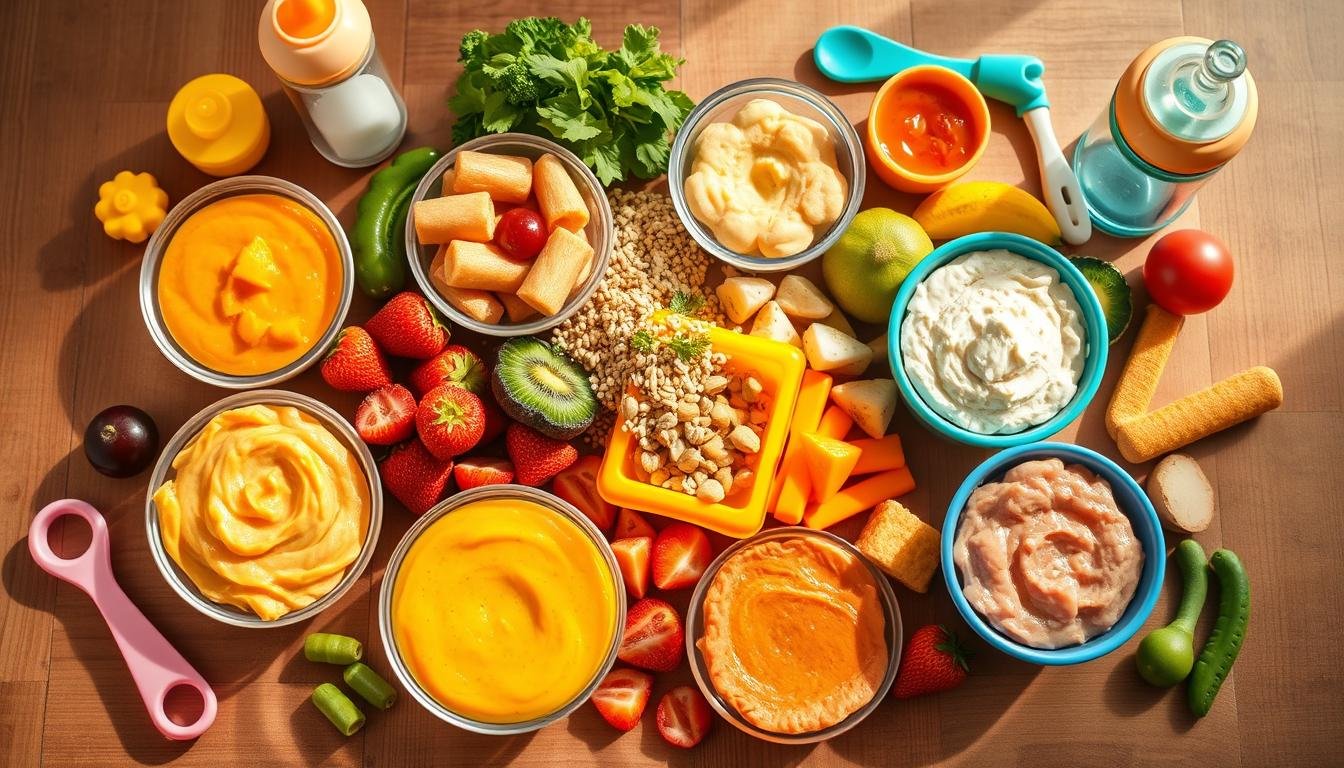Choosing the right foods for your baby in the first year is key. This is a time of fast growth and learning. The American Academy of Pediatrics (AAP) says to start with breast milk for about 6 months. Then, add solid foods and keep breastfeeding or using formula for a year.
It’s also vital to give your baby enough vitamin D. You can do this with supplements, formula, or cow’s milk.
At first, breast milk or formula should be your baby’s main food. Starting solid foods too early can make mealtime hard and lead to extra weight. The AAP suggests at least 400 IU of vitamin D daily for babies, kids, and teens. This helps with healthy growth and development.
Introduction to Baby Feeding
The first year of a baby’s life is very important for growth and development. Proper nutrition during this time is key for your baby’s fast growth. Starting healthy eating habits early is crucial for a lifetime of good food choices.
Importance of Proper Nutrition in the First Year
Babies grow and change a lot in their first 12 months. They grow faster than at any other time in their lives. It’s important to give them a variety of nutritious foods to support this growth.
Breast milk or formula should be their main food source for the first year. Solid foods should be introduced around 4-6 months of age.
Establishing Healthy Eating Habits Early On
Starting good eating habits early is key for a lifelong love of healthy foods. Introduce your baby to many flavors and textures early on. This makes them more open to trying new foods.
Also, keep mealtime calm and free from distractions. This helps create a positive relationship with food.
By focusing on baby feeding, first-year nutrition, and developing healthy eating habits, you can help your child stay healthy for life. Always talk to your pediatrician for advice on introducing solid foods and meeting your baby’s nutritional needs.
Breastfeeding Recommendations
Breastfeeding is the best way to feed your baby. In the first days, aim to breastfeed every 2-3 hours, even at night. It’s important to quickly respond to your baby’s hunger signals to build a strong bond.
Feeding Cues and On-Demand Feeding
Watch for signs your baby wants to eat, like sucking, rooting, or getting upset. Feed your baby whenever they show these signs. This lets them control how much they eat. Make sure to switch breasts and let them finish each one to get all the nutrients.
Pumping and Storing Breast Milk
If you can’t breastfeed directly, a breast pump can keep your milk supply up. You can store the milk safely in the fridge or freezer. This way, your baby can still get the benefits of breast milk even when you’re not there.
Formula Feeding Guidelines
When breast milk isn’t an option, standard infant formula is a good choice for most full-term babies. Formula feeding needs careful thought to meet your baby’s nutritional needs. Let’s look at the guidelines for formula feeding. We’ll help you pick the right formula and learn how to bottle-feed correctly.
Choosing the Right Formula
Finding the right formula can be tough, but it’s key for your baby’s health. Most babies do well with cow’s milk-based formulas. But, some might need special formulas like hydrolyzed protein or soy-based ones for allergies or dietary needs. Always check with your pediatrician to find the best formula for your baby.
Bottle-Feeding Techniques
Using the right bottle-feeding techniques is important for your baby’s comfort and growth. Hold the bottle flat and tilt it so the nipple is always full of formula. This stops your baby from swallowing air. Listen to your baby’s hunger and fullness signs, and don’t overfeed. As your baby eats more solids, they’ll need less formula, but it’s still a key nutrient source in the first year.
By following these guidelines, you can make sure your baby gets the nutrients they need for healthy growth. Remember, every baby is different. Be ready to adjust your approach as you learn your baby’s feeding habits and likes.
What to Feed Your Baby for Healthy Growth
When your baby is about 6 months old, it’s time to start with solid foods. This is a big step, as solid foods give important nutrients for growth. When choosing what to feed your baby, pick foods that are good for their body and mind.
Age-Appropriate Solid Food Introduction
Start with small amounts of iron-fortified cereal, pureed fruits, and veggies. As your baby gets older, add more foods and textures. Begin with single foods to watch for allergies.
Nutrient-Dense Baby Foods
- Give your baby a variety of fruits, veggies, meats, and grains for different tastes and nutrients.
- Choose foods high in iron, zinc, folate, and vitamins for your baby’s growth and brain.
- Add healthy fats like avocado, salmon, and whole-milk yogurt for energy and nutrients.
Introducing solid foods takes time and patience. It might take a few tries for your baby to like a new food. By offering many nutrient-rich foods, you help your baby develop good eating habits for life.
Introducing Solid Foods
When your baby is about 6 months old, it’s time to introduce solid foods. This is a big step in their growth, as they try new tastes and textures. Starting solid foods should be done carefully to ensure a healthy beginning.
The American Academy of Pediatrics suggests starting solid foods at 6 months. Your baby should be able to sit up, reach for objects, and swallow food. Always check with your pediatrician before starting to make sure your baby is ready.
Begin with small amounts of food, using a spoon or letting your baby use their fingers. As they get used to it, add more types and textures of food. Give them foods rich in nutrients like fruits, veggies, and whole grains for their growth.
Introducing solid foods is a learning experience for both you and your baby. Be patient and offer many different foods. Watch for signs that your baby is full or wants to try something new. This helps build good eating habits for life.
Transitioning to Table Foods
When your baby is 9-12 months old, it’s time to introduce more table foods. This includes finger foods and chunkier textures. It’s a big step towards developing important motor skills and independence at mealtime.
Finger Foods and Textures
Start with soft, small pieces of fruits, veggies, and proteins. These are easy for your baby to pick up and try. Good choices are soft-cooked carrot sticks, small chicken pieces, or ripe avocado.
Encouraging Self-Feeding
- Give your baby soft-tipped spoons to help them feel independent at meals.
- Offer different textures, moving from purées to foods like puff snacks or soft table foods.
- Let your baby get messy with their food. It helps with motor skills and avoids picky eating.
Remember, moving to table foods is a slow process. Every baby is different. With patience and help, your baby will learn to eat well for years to come.
Avoiding Potential Hazards
As your baby starts to try new foods, it’s key to watch out for dangers. Foods like hot dogs, nuts, seeds, round candies, popcorn, and thick peanut butter are choking hazards. They should be kept away until your baby is at least 3 or 4 years old.
It’s also important to look out for signs of food allergies when introducing new foods. If your baby has a rash, swelling, or trouble breathing, call your pediatrician right away. Making sure food is handled and prepared safely can also help keep your baby healthy and safe.
Choking Risks and Food Allergies
- Avoid foods that can easily block a child’s airway, like hot dogs, nuts, seeds, round candies, popcorn, and thick peanut butter, until after age 3 or 4.
- Watch for signs of food allergies when introducing new foods, such as rash, swelling, or breathing difficulties, and discuss any concerns with your pediatrician.
- Practice proper food handling and preparation to prevent foodborne illness and keep your baby safe.
By being careful about choking risks, food allergies, and safety, you can make sure your baby’s meals are both healthy and fun.
Developing Healthy Eating Habits
The foods you offer and your eating habits during pregnancy and early years shape your child’s taste. Offering a variety of fruits, vegetables, and nutritious foods helps them prefer healthy options. Make mealtime positive and stress-free to foster a good food relationship.
Babies may need to try a food 20 times before liking it. Not liking a new food at first doesn’t mean they won’t like it later. It’s important to expose them to different tastes and textures to help them enjoy a variety of foods.
Ensure babies eat in a safe place, away from hot drinks and potential hazards. Letting them explore food with their senses and encouraging self-feeding helps them accept and enjoy food. This approach boosts their independence and food acceptance.
Pay attention to your baby’s fullness cues, whether breastfeeding or eating solids. This helps build a healthy relationship with food. Starting these habits early sets your child up for a lifetime of good eating choices and positive mealtime experiences.
Every child is different, and finding the right approach takes time and patience. Create a nurturing space where your baby can enjoy a variety of healthy foods. This leads to lasting, healthy eating habits.
Conclusion
Feeding your baby right in the first year is key for their growth. The American Academy of Pediatrics (AAP) has guidelines for this. They help your child start good eating habits early.
Offering a variety of foods and making mealtime fun is important. This helps your baby grow healthy for life.
With 25% of American kids now obese, good nutrition is crucial. Childhood obesity can lead to serious diseases later. These include diabetes, cancer, stroke, and heart disease.
This baby feeding guide can help prevent obesity. It ensures your child gets the nutrients they need. The first years are vital for building healthy habits.
With the right steps, you can set your child up for a healthy future. Give them a strong start for a lifetime of wellness.





